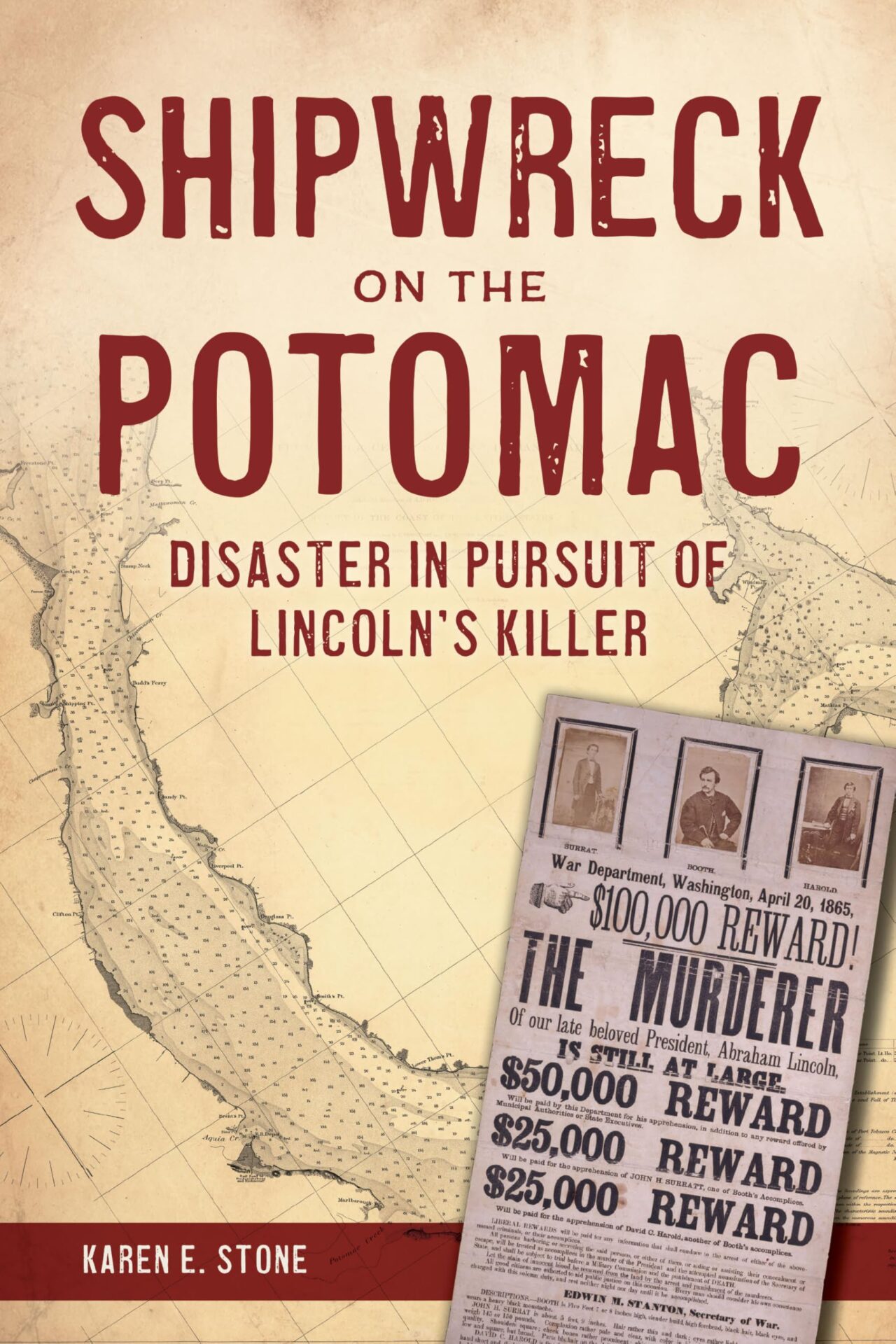Book Review: Shipwreck on the Potomac: Disaster in Pursuit of Lincoln’s Killer
Shipwreck on the Potomac: Disaster in Pursuit of Lincoln’s Killer. By Karen E. Stone, Charleston, SC: History Press, 2025. Softcover, 128 pp. $21.49.
Reviewed by Robin Friedman
The study of the Civil War often involves learning about grand, sweeping, history-changing events. But just as often are encounters with many smaller, less well-known—but still important—happenings associated with those of larger scope. Karen E. Stone’s book, Shipwreck on the Potomac: Disaster in Pursuit of Lincoln’s Killer, is a book about one such smaller scale event. It is apparently the first book-length study of an April 25, 1865, disaster that occurred following the assassination of President Abraham Lincoln. In Shipwreck on the Potomac, Stone’s first book, she tells this tragic story well and places it within its proper historical context.
Stone serves as the museum division manager for St. Mary’s County, Maryland. St. Clement’s Island—at the time of the shipwreck known as Blackistone Island—is the location of one of the St. Mary’s County’s museums and is near where the events of Stone’s study took place. The museum presents an annual event commemorating the April 25, 1865 shipwreck.
On a pitch black night at about 1:00 a.m. on April 25, the steamer Massachusetts collided with the barge Black Diamond, off the Blackistone Island coast in southern Maryland. An old, dilapidated ship, the Massachusetts was also overloaded, carrying 300 men, most of whom were Union soldiers returning from southern prisoner of war camps. The Black Diamond, containing a crew of 17, was among the craft plying the Potomac River as a participant in a blockade of the southern Maryland coast to prevent Lincoln’s assassin, John Wilkes Booth, from crossing into Virginia. Unbeknownst to the blockade, and making the event even more tragic, was the fact that Booth had already crossed the Potomac, arriving in Virginia on the morning of April 23. Three days later, Union soldiers killed Booth and captured an accomplice, David Herold. Thus, in hindsight, the blockade had become unnecessary when the disaster took place.
The collision ripped a large gash in the side of the Black Diamond, and its bow began to sink immediately. The two vessels were side-by-side when the captain of the Massachusetts ordered his men to jump ship to the Black Diamond. About 150 men did so, resulting in the Black Diamond sinking within about three minutes. Many men spent hours in the frigid Potomac waters. A total of 87 men died, seven from the Black Diamond and 80 from the Massachusetts. Of the men that died, only the names of 26 are known. The bodies of some of the deceased were recovered and received proper burials, while the bodies of others remain in the Potomac River. Stone is continuing her efforts to learn more about the deceased men; she writes: “a man is only missing if he is forgotten.” (9)
Over the final three chapters of her eight-chapter book, Stone eloquently tells the story of the unfortunate shipwreck, its aftermath, the resulting court of inquiry, which found negligence with the captains of both vessels, and the disposition of the recovered bodies. The earlier chapters of the book consist of a great deal of stage setting, some of which may distract from the story.
The early chapters provide background information to the disaster, but also substantially more, including the actions of the Potomac Flotilla, which served throughout the conflict to minimize the provision assistance provided from Confederate sympathizers in southern Maryland to the Confederacy, just across the Potomac River. The book also describes the system of lighthouses along the Potomac River, the laws governing their use, and the system of licensing private vessels, including both the Massachusetts and the Black Diamond during the war effort. Additionally, Stone presents a chapter on the men aboard both ships and on the large manhunt to capture Booth and his accomplices in the aftermath of Lincoln’s assassination.
The book concludes with eight appendices, which include documents and eyewitness testimony, a list of the known dead, their burials, and the memorialization of the incident. Stone also offers a timeline of the Civil War designed to refer to the disaster and its background. Shipwreck on the Potomac is well documented with notes and an impressive list of historical references. Many historical photographs and images enhance Stone’s work, including a painting of the shipwreck by a local artist, Angela Wathen, who gifted her work to the St. Clement’s Island Museum. A map of the relevant sections of the Potomac River from southern Maryland to Virginia would have been a welcome addition.
Stone’s Shipwreck on the Potomac is a valuable study that examines an incident worthy of remembrance. However, as she importantly points out, other eclipsing events such as the killing of Booth on April 26, the surrender of Joseph E. Johnston’s Army of Tennessee to Gen. William T. Sherman on the same day, and the explosion of the steamboat Sultana on the Mississippi River on April 27, 1865 (the worst maritime disaster in United States history), all helped obscure the tragic shipwreck on the Potomac.
Robin Friedman retired from a career as an attorney with the United States Department of the Interior in 2010. In retirement, he pursues his passion for American studies, including literature, history, philosophy, and the Civil War.

